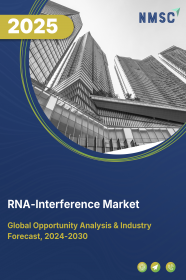
RNA-Interference (RNAi) Market by Product Type (Small Interfering RNA (siRNA), MicroRNA (miRNA), and Others), and by Application (Drug Discovery & Development and Therapeutics)- Global Opportunity Analysis and Industry Forecast 2024-2030
US Tariff Impact on RNA-Interference Market
Trump Tariffs Are Reshaping Global Business
RNA-Interference Market Overview
The global RNA-Interference Market size was valued at USD 5.4 billion in 2023 and is predicted to reach USD 14.7 billion by 2030 with a CAGR of 15.3% from 2024-2030.
The RNA-interference (RNAi) market encompasses the global industry dedicated to the development, production, and commercialization of RNAi-based therapeutics and research tools. RNAi is a biological process that selectively silences gene expression by targeting specific mRNA molecules, offering promising opportunities for the treatment of various diseases, including cancer, genetic disorders, and viral infections.
The market features a wide range of RNAi-based products, including small interfering RNA (siRNA), microRNA (miRNA), and short hairpin RNA (shRNA), tailored for therapeutic intervention and functional genomics research. The advantages of the RNAi market include its potential to provide highly targeted and specific treatments, minimizing off-target effects and reducing the likelihood of adverse reactions.
Additionally, RNAi-based therapeutics offer the prospect of personalized medicine, enabling tailored treatment approaches based on individual genetic profiles.
Market Dynamics and Trends
The growing prevalence of chronic diseases globally, including cancer, cardiovascular disorders, and metabolic conditions, is driving an increased demand for RNA-interference (RNAi) as a promising therapeutic approach. RNAi offers a targeted and precise mechanism to prevent disease-causing genes, addressing the underlying molecular mechanisms of various illnesses.
It offers personalized treatment options tailored to individual genetic profiles, thus contributing to the growing demand for RNAi in combating chronic diseases.
According to the World health Organization report 2022, cardiovascular diseases accounts for 17.9 billion deaths annually, followed by 9.3 billion deaths from cancers, 4.1 billion from chronic respiratory diseases, and 2.0 billion from diabetes, including kidney disease deaths caused by diabetes. This rise in chronic diseases increase the adoption of such innovative therapies, offering precise and tailored treatments to address underlying molecular mechanisms.
Moreover, the increasing approvals for RNAi therapies further accelerates the growth of the market by increasing confidence among stakeholders, fostering investment, and expanding accessibility to innovative treatment options for various diseases. RNAi-based therapeutics are capable to treat a wide range of diseases, and are effective in preclinical and clinical studies.
As a result, regulatory bodies such as the U.S. Food and Drug Administration (FDA) and the European Medicines Agency (EMA) approves RNAi-based therapeutics for use in humans. For instance, in October, 2023, FDA approved Rivfloza for children aged 9 and older and adults with Primary Hyperoxaluria Type 1 (PH1), a rare genetic disorder.
This propels the market growth by expanding the availability of innovative treatment options and boosting investor confidence in the viability of RNA-interference technology.Furthermore, the increasing use of advanced technologies, such as AI, machine learning, and high-throughput screening, is driving significant growth in the drug discovery and development market.
These technologies are transforming how researchers identify and validate potential drug targets, optimize lead compounds, and conduct preclinical studies, making the process faster and more efficient. RNAi technology is a powerful tool that helps to identify new drug targets and develop new drugs.
As a result, pharmaceutical and biotech companies are increasingly using RNAi technology in their drug discovery and development efforts. Overall, the growing integration of RNAi technology into drug discovery and development processes leads to the introduction of a new generation of breakthrough therapies, positioning the RNAi market for sustained growth in the coming years.
However, the research and development of RNAi-based therapeutics is an expensive process, requiring significant investment in advanced technology, clinical trials, and regulatory approvals. These high costs create barriers to entry for smaller companies, limiting their ability to compete in the market, thus restraining the growth of the market.
On the other hand, the development of new types of siRNA molecules, such as locked nucleic acid (LNA) siRNA, that are more stable and efficient than traditional siRNA molecules is expected to create ample growth opportunities for the market in the upcoming years.
Market Segmentation and Scope of Study
The global RNA-interference market report is segmented on the basis of product type, application, and geography. Based on product type, the market is classified into small interfering RNA (siRNA), microRNA (miRNA), and others. Based on the application, the market is segmented into drug discovery & development and therapeutics.
Therapeutics is further subdivided into, oncology, ocular disorders, respiratory disorders, hepatitis B and C, autoimmune hepatitis, neurological disorders, and other therapeutics. Geographical breakdown and analysis of each of the aforesaid classifications include regions comprising of North America, Europe, Asia-Pacific, and RoW.
Geographical Analysis
North America dominates the global RNA-interference industry and is expected to remain dominant in the market throughout the forecast period. This is attributed to the rising incidence of chronic diseases in the countries such as U.S. and Canada that drives the RNA-Interference market demand for advanced therapeutics and diagnostics. Chronic diseases such as cancer, diabetes, cardiovascular diseases, and neurodegenerative disorders are complex and often difficult to treat using conventional methods.
RNAi-based therapeutics offer a promising method for targeted gene silencing, that help to identify the disease-causing genes or proteins, for slowing down disease progression. According to the American Cancer Society’s report 2022, cancer continues to be the second most common cause of death in the U.S., that accounts for 609,360 deaths in 2022, that is about 1,670 deaths a day. This indicates a positive outlook for the market growth, driven by the need for more effective and precise treatment options for these chronic conditions.
Moreover, the growing governmental investment towards RNAi therapeutics further accelerating the market growth in the region by fostering research and development initiatives, supporting clinical trials, and facilitating regulatory approval processes. Governmental funding provides financial support for RNAi research and also signifies official recognition of the potential of RNAi technology in addressing unmet medical needs. This investment encourages collaboration between academia, industry, and regulatory agencies, fostering innovation and expediting the translation of RNAi discoveries into clinical applications.
As per the latest report published by the Government of Canada, in February, 2024 the Canadian government announced a contribution of USD 148.7 billion for RNA Technologies & Therapeutics Inc. This investment aimed to boost innovation, research, and development in the field, for advancing Canada's capabilities in RNA-based therapies. Such governmental support enhances infrastructural development for RNAi manufacturing, distribution, and healthcare delivery systems, ultimately improving the accessibility and demand for RNAi-based therapies.
On the other hand, the Asia-Pacific region is expected to show a steady rise in the RNA-interference market growth. This is due to the growing collaboration among regional players such as Arrowhead Pharmaceuticals, Vivo Capital, and Boehringer Ingelheim towards the development of RNAi therapies by pooling resources, expertise, and infrastructure, accelerating research and innovation. The partnerships foster innovation and accelerate the development of RNAi technologies by sharing knowledge and technology across borders. Additionally, collaborative efforts streamline regulatory processes and enhance the efficiency of clinical trials, making it easier to bring RNAi-based therapies to market.
In April 2022, Vivo Capital partnered with Arrowhead Pharmaceuticals to form a new company named Visirna Therapeutics with an investment of around USD 60 billion. This venture brought four of Arrowhead's RNAi therapies for cardiometabolic diseases to China, including mainland China, Hong Kong, Macau, and Taiwan. Such collaborative efforts expand the market reach, reduce costs, and improve patient access to cutting-edge RNAi treatments, driving overall market expansion.
Additionally, the rising healthcare expenditure in the region accelerates the demand for RNA-interference (RNAi) therapies by enabling more investment in advanced medical technologies and innovative treatments. The expansion in healthcare budgets leads to greater financial capacity to support research, development, and adoption of cutting-edge therapies such as RNAi.
As per the report published by the India Brand Equity Foundation 2024, the Indian healthcare industry experienced robust growth in 2022, reaching a value of USD 372 billion, with healthcare expenditure accounting for about 2.2% of the country's GDP. This rise in healthcare spending enhances the ability to conduct clinical trials, improve delivery mechanisms, ultimately propelling the adoption of RNAi-based treatments in the region.
Competitive Landscape
The RNA-Interference industry comprising of various key players such as Alnylam Pharmaceuticals Inc., Benitec BioPharma, Ionis Pharmaceuticals Inc., Sirnaomics Ltd., Switch Therapeutics, Silence Therapeutics PLC, Arrowhead Pharmaceuticals Inc., Thermo Fisher Scientific Inc., Boehringer Ingelheim, and Novartis. These companies are adopting various strategies such as partnership and collaboration to stay competitive and maintain their market positions.
For instance, in January 2024, Boehringer Ingelheim partnered with Ribo to develop RNA-based therapeutics for nonalcoholic steatohepatitis (NASH) and metabolic dysfunction. The collaboration aimed to develop RNA-based therapeutics to advance treatment options and address unmet medical needs in metabolic liver diseases.
Also, in July 2023, Alnylam Pharmaceuticals, Inc. collaborated with Roche to develop and commercialize Zilebesiran, an investigational RNAi therapeutic for hypertension that is in Phase 2 trials. This partnership aimed to revolutionize hypertension treatment globally and supports the innovation and growth of the market.
Furthermore, in March 2023, Switch Therapeutics launched its novel RNAi technology to develop a first-of-its-kind RNAi platform designed to silence multiple disease-causing genes simultaneously. This product launch supports the preclinical and clinical development of the company’s innovative therapies, focusing on unmet medical needs in neurology and other therapeutic areas.
Moreover, in February 2022 Sirnaomics Ltd. launched the start of a Phase one clinical trial for evaluation of the safety, tolerability, and anti-tumor activity of the company's SiRNA (Small interfering RNA) drug candidate, STP707 with intravenous (IV) administration in the United States.
Key Benefits
-
The report provides quantitative analysis and estimations of the RNA-interference market from 2024 to 2030, which assists in identifying the prevailing market opportunities.
-
The study comprises a deep dive analysis of the current and future RNA-interference market trends to depict prevalent investment pockets in the industry.
-
Information related to key drivers, restraints, and opportunities and their impact on the RNA-interference market is provided in the report.
-
Competitive analysis of the players, along with their market share is provided in the report.
-
SWOT analysis and Porters Five Forces model is elaborated in the study.
-
Value chain analysis in the market study provides a clear picture of roles of stakeholders.
RNA-Interference Market Key Segments
By Product
-
Small interfering RNA (siRNA)
-
MicroRNA (miRNA)
-
Other
By Application
-
Drug Discovery & Development
-
Therapeutics
-
Oncology
-
Ocular Disorders
-
Respiratory Disorders
-
Hepatitis B and C
-
Autoimmune Hepatitis
-
Neurological Disorders
-
Other Therapeutics
-
By Region
-
North America
-
The U.S.
-
Canada
-
Mexico
-
-
Europe
-
The UK
-
Germany
-
France
-
Italy
-
Spain
-
Denmark
-
Netherlands
-
Finland
-
Sweden
-
Norway
-
Russia
-
Rest of Europe
-
-
Asia Pacific
-
China
-
Japan
-
India
-
South Korea
-
Australia
-
Indonesia
-
Singapore
-
Taiwan
-
Thailand
-
Rest of Asia Pacific
-
-
RoW
-
Latin America
-
Middle East
-
Africa
-
Key Players
-
Alnylam Pharmaceuticals, Inc.
-
Benitec Biopharma
-
Ionis Pharmaceuticals, Inc.
-
Sirnaomics Ltd.
-
Switch Therapeutics
-
Silence Therapeutics Plc
-
Arrowhead Pharmaceuticals, Inc.
-
Thermo Fisher Scientific Inc
-
Boehringer Ingelheim
-
Novartis
REPORT SCOPE AND SEGMENTATION
|
Parameters |
Details |
|
Market Size in 2023 |
USD 5.4 Billion |
|
Revenue Forecast in 2030 |
USD 14.7 Billion |
|
Growth Rate |
CAGR of 15.3% from 2024 to 2030 |
|
Analysis Period |
2023–2030 |
|
Base Year Considered |
2023 |
|
Forecast Period |
2024–2030 |
|
Market Size Estimation |
Billion (USD) |
|
Growth Factors |
|
|
Countries Covered |
28 |
|
Companies Profiled |
10 |
|
Market Share |
Available for 10 companies |
|
Customization Scope |
Free customization (equivalent up to 80 working hours of analysts) after purchase. Addition or alteration to country, regional, and segment scope. |
|
Pricing and Purchase Options |
Avail customized purchase options to meet your exact research needs. |

















 Speak to Our Analyst
Speak to Our Analyst




















